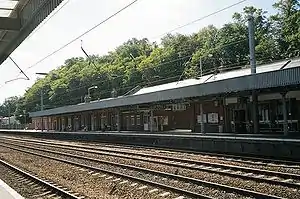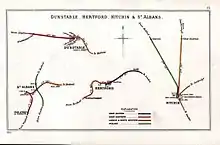Hitchin railway station
Hitchin railway station serves the town of Hitchin in Hertfordshire. It is located approximately 1 mile (1.6 km) north east of the town centre and 31 miles 74 chains (51.4 km) north of London King's Cross on the East Coast Main Line.[1]
 The tracks and platform 2 | |
| Location | Hitchin, District of North Hertfordshire England |
| Grid reference | TL194297 |
| Managed by | Great Northern |
| Platforms | 2 |
| Other information | |
| Station code | HIT |
| Classification | DfT category C2 |
| History | |
| Original company | Great Northern Railway |
| Post-grouping | London and North Eastern Railway |
| Key dates | |
| 7 August 1850 | Station opened |
| Passengers | |
| 2015/16 | |
| 2016/17 | |
| 2017/18 | |
| 2018/19 | |
| Interchange | 0.174 million |
| 2019/20 | |
| Interchange | |
| Notes | |
Passenger statistics from the Office of Rail and Road | |




Until the current Stevenage station opened in 1973, many Intercity services stopped at Hitchin.
In August 2007 Hitchin was awarded Secure Station status after improvements to station security were made by First Capital Connect, including new lighting, extra CCTV and the installation of automatic ticket gates.
History
The first section of the Great Northern Railway (GNR) - that from Louth to a junction with the Manchester, Sheffield and Lincolnshire Railway at Grimsby - opened on 1 March 1848, but the southern section of the main line, between Maiden Lane and Peterborough, was not opened until August 1850. Hitchin was one of the original stations, opening with the line on 7 August 1850.[2][3][4]
On 21 October 1850 Hitchin became a junction station with the opening of the first section of the Royston and Hitchin Railway, between Hitchin and Royston (it was extended to Shepreth on 3 August 1851).[5] The Midland Railway (MR) opened a route from Leicester via Bedford to Hitchin on 1 February 1858, by which MR trains used the GNR to reach London.[6]
After the opening of the Midland Railway's own line from Bedford via Luton to London, and the line's terminus at St. Pancras in 1868, their line between Bedford and Hitchin was reduced to branch status. It lost its passenger service in 1961 and was closed completely in 1964, with the exception of a stub from Bedford to Cardington which itself was closed in 1969. In May 1964 part of the line was used for the railway scene in the film Those Magnificent Men in their Flying Machines.[7] The embankment for the line could, until early 2012, still be walked from just north of the station, through the fields to Ickleford, but this section is now closed off. Opened in June 2013 a new embankment now carries a single-track line onto a viaduct for Letchworth-bound trains over the East Coast Main Line as part of the Hitchin Flyover project.[8]
Accidents and incidents
- On 14 April 1949, the solicitor and historian Reginald Hine died by suicide here by jumping in front of the slow train from Cambridge.[9][10]
- On 19 November 1958, a freight train overran signals and was in a rear-end collision with another. A third freight train ran into the wreckage.[11]
Facilities
There are 12 car platforms on the Up and Down Slow lines only. 17 chains (340 m) to the north of the station is Cambridge Junction, where northbound trains for Cambridge need to cross the two Up (southbound) lines.[1]
Following a refurbishment of the station by First Capital Connect in 2007, the station's subway was refurbished at a cost of £300k.[12] The refurbishment also involved general cosmetic work throughout the station, as well as a new high quality waiting room in the existing station buildings on Platform 2. This waiting room is fully accessible at all times via the automatic doors.
There is a small shop located by the stairs on Platform two, and various vending machines throughout the station.
The station has a large booking office and a variety of modern Touch Screen ticket machines located in the booking office, and the station's cycle facilities were completely upgraded in 2007 and now include sheltered spaces for 68 bicycles provided next to the station buildings. The station also has help points throughout.
Hitchin station now has automatic ticket gates at the station entrance, which were installed by First Capital Connect during 2007.
In 2013, Network Rail proposed plans for two new lifts, one on each platform to improve access via the existing subway for those with pushchairs or disabilities, funded through the Department for Transport’s Access for All scheme.[13] In September 2014 the new lifts opened, after a two-month delay, giving step-free access to the southbound number 1 platform.[14]
Platforms and Services
Platforms
Hitchin railway station is managed by Great Northern and has two platforms situated on the slow lines. Platform 1 is used for trains towards London and a few starting/terminating services to/from London. Platform 2 is used for trains towards Peterborough and Cambridge. Platform 1 also provides access to the sidings, used for removing stone and scrap metal.
Current Services
Off-peak, all services are operated by Thameslink using Class 700 EMUs.
The typical off-peak service in trains per hour is:[15]
- 2 tph to London King's Cross (all stations to Potters Bar, then semi-fast)
- 2 tph to Brighton via Gatwick Airport (semi-fast)
- 2 tph to Horsham via Redhill and Gatwick Airport
- 2 tph to Peterborough
- 4 tph to Cambridge (2 of these call at all stations and 2 are semi-fast)
During the peak hours, there are additional Great Northern services between London King's Cross and Baldock which call at the station. These services are operated using Class 365 or Class 387 EMUs.
Future services
It is proposed that a 2 tph service from Cambridge to Maidstone East via Welwyn Garden City and Swanley will begin operating once the Thameslink Programme is fully complete.[16] This would see the existing Cambridge to London service extended through the Thameslink Core and down to Maidstone.
It was initially proposed that this service would run to Tattenham Corner.[17] However this proposal was cancelled and replaced with the Maidstone East service.
This service was due to commence in December 2019 but has now been postponed to an unknown date.[18]
| Preceding station | Following station | |||
|---|---|---|---|---|
| Thameslink | ||||
| Thameslink | ||||
| Great Northern London to Baldock Peak Hours Only | ||||
| Disused railways | ||||
Line and station closed | London, Midland and Scottish Railway | Terminus | ||
| Historical railways | ||||
Line open, station relocated | Great Northern Railway | Line open, station closed |
||
Junction development
Down trains from London to Cambridge used to use a ladder crossing over the up lines in order to reach the Cambridge Line, which often caused significant delays to trains in both directions. Together with the Digswell Viaduct some 10 miles (16 km) to the south, the flat junction just north of Hitchin was a major bottleneck.[19]
In June 2013 Network Rail completed a flyover to carry Down trains to Cambridge over the top of the main line,[20] built at a final cost of £47million [21]
References
- Yonge, John (September 2006) [1994]. Jacobs, Gerald (ed.). 2: Eastern. Railway Track Diagrams (3rd ed.). Bradford on Avon: Trackmaps. p. 15 section B. ISBN 0-9549866-2-8.
- Gordon, W.J. (1989) [1910]. Our Home Railways. London: Bracken Books. volume II, p. 44. ISBN 1-85170-314-4.
- Awdry, Christopher (1990). Encyclopaedia of British Railway Companies. London: Guild Publishing. p. 135. CN 8983.
- Butt, R.V.J. (1995). The Directory of Railway Stations. Yeovil: Patrick Stephens Ltd. p. 121. ISBN 1-85260-508-1. R508.
- Awdry 1990, p. 158
- Gordon 1989, volume I, pp. 77–8
- Howard, Philip (2006). Take the Train from Hitchin. Hitchin: Hitchin Historical Society. pp. 20–22. ISBN 0-9552411-0-3.
- Network Rail. "Hitchin Flyover". Retrieved 15 April 2010.
- Whitmore, Richard (2007). The Ghosts of Reginald Hine. Hitchin: Mattingley Press. p. 183. ISBN 978-0-9554662-0-5.
- Fleck, Alan L. (2004). "Hine, Reginald Leslie (1883–1949)". Oxford Dictionary of National Biography. Oxford University Press. Retrieved 16 December 2016.
- Trevena, Arthur (1981). Trains in Trouble: Vol. 2. Redruth: Atlantic Books. pp. 40–14. ISBN 0-906899 03 6.
- "Archived copy". Archived from the original on 17 March 2010. Retrieved 9 May 2010.CS1 maint: archived copy as title (link)
- Access for All: funding to improve accessibility at rail stations
- http://www.thecomet.net/news/new_lifts_open_at_hitchin_railway_station_1_3759516
- "Timetable 14: Hitchin and Stevenage to London" (PDF). Govia Thameslink Railway, December 2019.
- Timetable consultation : Southern
- Proposed Thameslink service pattern
- "Thameslink at Maidstone East will not launch in December 2019". Kent Online, September 2019.
- "APPENDIX 2: Issues in defining and measuring railway capacity" (PDF). Office of Rail Regulation. 13 February 2006. p. 2. Retrieved 28 February 2014.
- "Hitchin flyover". Network Rail. Retrieved 16 June 2011.
- http://www.railwaygazette.com/news/infrastructure/single-view/view/hitchin-flyover-opens.html
External links
- Train times and station information for Hitchin railway station from National Rail
- Hitchin: Here we explain our plans to improve the rail links between London, Hitchin and Cambridge on Network Rail website